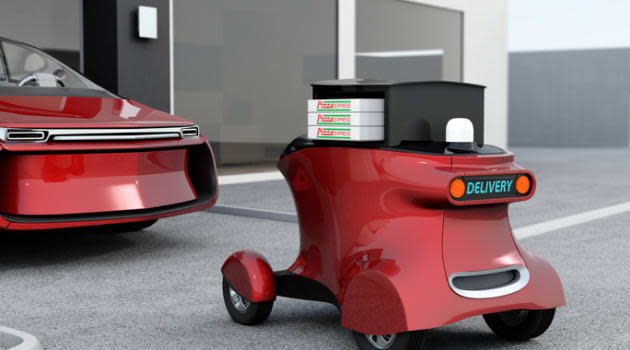Here's What You Need To Know About Singapore’s Food Delivery Robots

Singaporeans flocked to food delivery after it was announced that dining-in was prohibited during Circuit Breaker. Today, despite being allowed to dine-in at restaurants in larger groups, the habit of ordering food online and having it delivered to the doorstep is likely to stay. According to research firm Statista, Singapore’s revenue in the online food delivery segment is expected to amount to US$541 million this year, a 16% increase compared to 2020. Challenges are already emerging from the surge in demand, with a limited pool of riders being one of the most prominent ones. Below, we explore the potential of food delivery bot as a solution to this issue – and its broader implications on consumers, businesses, and delivery riders.
What Does A Food Delivery Bot Do? How Much Are Its Delivery Costs?
FoodBot is the first self-driving outdoor delivery robot. It was conceptualised and subsequently launched by student start-up Whizz Mobility last June to deliver food from vendors at NTU’s Yunnan Campus across the university compounds. Of course, it’s worth noting that there is still human help involved in the delivery process; Whizz personnel will first collect and sort the orders before putting them inside the rovers and sending them off on pre-mapped delivery routes. Each FoodBot can carry a 50 kg load and move at 5 km/h – pedestrians' average walking speed. Its onboard cameras and algorithms (i.e. relies on artificial intelligence) help it navigate obstacles along the way. That said, Whizz does pay students to monitor FoodBot’s camera feed in real-time remotely so that they can control the robot's movements when necessary, such as when the bot reaches busy intersections like road crossings. As of date, Whizz does not levy a 'delivery fee' on consumers making use of FoodBot’s services.
Can Food Bots Translate To Long-Term Cost Savings For Businesses?
The exact production costs of a FoodBot is undisclosed. However, the Whizz team has hinted that it's relatively inexpensive, given that it's made up of 3D-printed parts and self-designed custom-printed circuit boards. Nonetheless, a reasonable estimate can be gleaned from the cost of a bot from Starship: GBP$5,500 (SG$10,219). As steep as this ‘initial investment’ might seem, you shouldn’t forget about the various costs business owners are currently facing, including commission charges from delivery platforms (up to 35%) and the monthly salaries of full-time delivery riders (S$1,800 to S$2,000 a month). Thus, it’s not difficult to see how FoodBot could indeed translate to long-term operational savings for businesses in Singapore.
Delivery Platform | Activation Fee | Service Fee/Commission | Payment Gateway Fee |
|---|---|---|---|
Grabfood | One-time fee charged per outlet Android device: S$100/outlet Grab Order Device: S$300/outlet | 30% charged on every delivery, subjected to 7% GST | 0% (absorbed by Grab) |
Deliveroo | Up to S$360 deducted over a period of 60 days | No information | No information |
foodpanda | One-time S$100 fee | 35% commission on total order value, subjected to 7% GST | 3% charge |
Oddle Eats | S$0 set-up fee | 10% commission for successful transaction | 0% |
WhyQ | S$0 set-up fee | No commission, but marks up food prices by about 5% | No information |
Deliver SG | N/A | No commission, but marks up food prices by about 10% | No information |
Information obtained from delivery platforms above, subject to changes.
How Do Food Bots Affect Consumers?
It’s not just food merchants who are feeling the pinch from the delivery platforms’ high commission fees; consumers are also paying roughly S$4 per order in delivery fees. Should FoodBot’s delivery fee remain at zero, that would translate to serious cost-savings. However, this is unlikely to happen – merchants will likely charge for deliveries. Even then, it's postulated that merchants' charges will be cheaper than major food delivery platforms' fees. Another significant boon associated with the widespread adoption of FoodBots is contactless delivery, which is particularly applicable in light of the ongoing pandemic.
Delivery Platform | Delivery Fee/S$ | Minimum Order/S$ |
|---|---|---|
Grabfood | 3 to 5 | 8 |
Deliveroo | 3 | 5 for orders below S$12 |
foodpanda | 0.99 to 2.99 | 10 |
Oddle Eats | Varies according to food merchant | Varies according to food merchant |
WhyQ | 1.50 per dish | None |
Deliver SG | Calculated based on distance | None |
Information obtained from delivery platforms above, subject to changes.
Will Food Bots Eliminate Delivery Riders?
At this point, it's doubtful that FoodBot will eliminate the need for delivery riders. Many issues still need to be addressed before FoodBot can be a viable option for the rest of Singapore. One of the most significant ones is that of existing infrastructure. These rovers will compete for space on Singapore's busy urban streets – and the government is bound to have to regulate this for safety issues (as with that of e-scooters on public paths). It remains to be seen how this will play out in the near future.
Food Bots Are An Exciting Glimpse Into What’s Possible In The Future
While a promising idea, there's no denying that there will be many issues that need to be addressed before businesses and consumers can enjoy savings on food deliveries. Before suitable solutions are proposed for these concerns, it appears that delivery riders can breathe easy. Nonetheless, it's clear that delivery robots will play an increasingly important role in improving last-mile deliveries – and this is a definite must-watch space.
Resources From ValueChampion
Read Next
This article originally appeared on The ValueChampion Blog.
ValueChampion helps you find the most relevant information to optimise your personal finances. Like us on our Facebook page to keep up to date with our latest personal finance articles.

 Yahoo Finance
Yahoo Finance 
